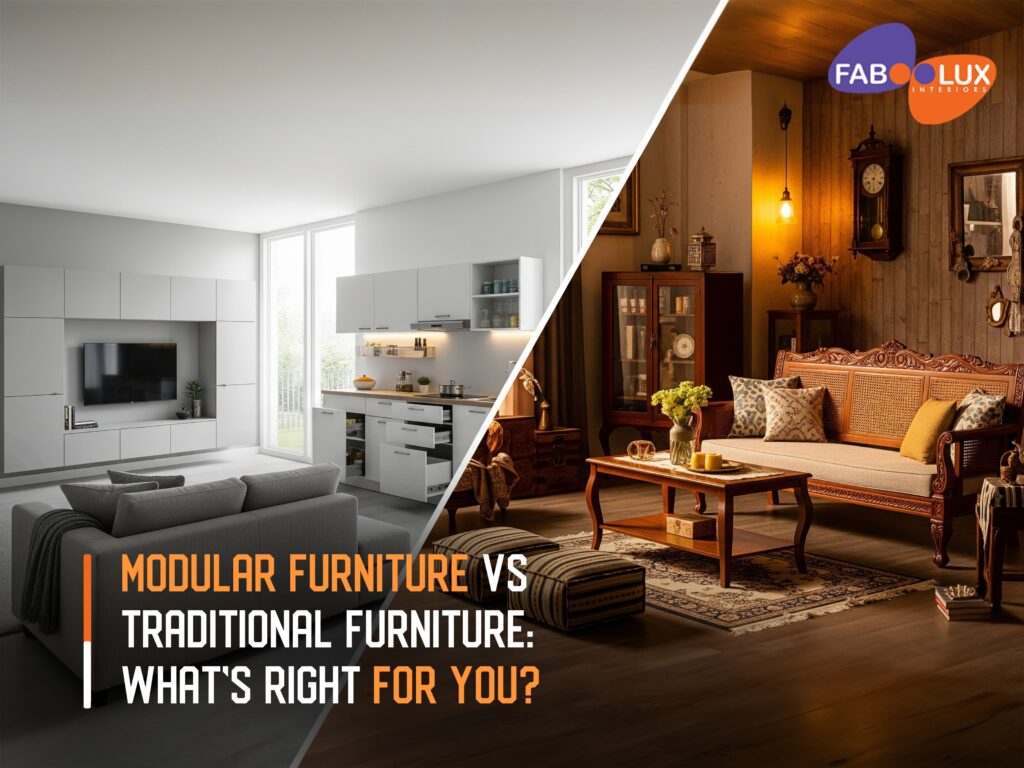Interior design isn’t just about walls, floors, and lighting—furniture plays a pivotal role in bringing functionality, personality, and harmony to a living space. The furniture you choose not only affects how your space looks but also how it works. With the increasing diversity in home designs, particularly in fast-growing cities like Kochi, homeowners are often faced with a key decision: should they opt for modular furniture or go for the timeless appeal of traditional furniture?
Each has its own philosophy, pros, and practical considerations. In this blog, we’ll explore these two styles in depth, helping you understand how they differ and which one might better suit your home, lifestyle, and personality.
1. Customization and Flexibility
Modular furniture is built with adaptability at its core. It’s composed of pre-manufactured units or modules that can be assembled in different ways to suit the space and the user’s needs. Whether you’re dealing with a tight corner in a studio apartment or a quirky layout in a modern duplex, modular designs can be tailored accordingly. For example, modular wardrobes come with adjustable shelves, sliding doors, or even removable drawers—letting you reshape your storage over time. The flexibility also extends to aesthetics. You can choose from a wide range of finishes—matte, glossy, wood grain, pastel, or bold colors—and combine materials like laminates, acrylics, glass, or even metal. Everything from the size and color to the layout can be personalized without altering the core structure.
On the other hand, traditional furniture tends to be more rigid in design. These pieces are often crafted as whole units, typically from solid wood, and are built to last in their original form. Customization is possible but usually limited to size and surface finish. If you want to change a traditional wooden bookshelf into something with more storage or change its orientation, you’d often have to commission an entirely new piece or hire a carpenter to modify it—something that’s not always practical or affordable. So when it comes to freedom of design, modular furniture opens more doors for creativity and future upgrades, especially for clients who want their homes to evolve with their lifestyles.

2. Space Utilization
Urban living often comes with space constraints. This is where modular furniture truly shines. It’s designed to optimize available space and make every inch functional. Think of corner-fitted wardrobes, wall-mounted TV units with hidden compartments, or beds with hydraulic storage. The philosophy here is simple: furniture shouldn’t just exist—it should serve a purpose beyond aesthetics. For example, a modular kitchen is built with compartments dedicated to maximize storage, workflow, and accessibility. Pull-out shelves, built-in spice racks, and rotating trays allow homeowners to make the most of every corner. In bedrooms, modular headboards might include reading lights, storage slots, or charging docks. Dining tables can double as workstations, and sofa sets can convert into beds for guests.In contrast, traditional furniture often adheres to standard proportions and doesn’t necessarily take space-saving into account. A classic four-poster bed or a solid teakwood cupboard may look stunning in a sprawling home but could feel overwhelming in a compact apartment. These pieces often require dedicated space and aren’t designed to adapt or fold away when not in use. While they contribute to a sense of grandeur, they may not be the best option for homes where efficient use of space is a priority. Hence, for smaller urban homes or for those who prefer minimalist, clutter-free spaces, modular furniture offers a clear advantage in intelligent space planning.

3. Aesthetic Appeal
Aesthetics play a vital role in defining the character of your home—and here’s where personal taste becomes key. Modular furniture embraces a sleek, minimalist, and contemporary aesthetic. It’s ideal for those who prefer clean lines, subtle textures, and a cohesive, streamlined look. Since modular designs follow current trends, you’ll often find options inspired by Scandinavian, industrial, or mid-century modern styles. Glossy finishes, glass panels, geometric patterns, and neutral color palettes are common. These elements work well in urban homes, especially when paired with modern lighting and open layouts. The visual continuity of modular furniture is also a huge plus. For example, you can design a kitchen, wardrobe, and living room storage units that follow a single design language—ensuring that every piece complements the other without feeling mismatched.Meanwhile, traditional furniture is rooted in craftsmanship, heritage, and timeless appeal. It often features ornate carvings, intricate woodwork, and rich materials such as teak, rosewood, or mahogany. From heavy-legged coffee tables to carved headboards, these pieces bring warmth, gravitas, and a touch of nostalgia. They’re often passed down generations, and each piece tells a story of its own. Traditional furniture is a natural fit for heritage-style homes or villas with larger rooms and classic architecture. It can also be blended into modern homes as statement pieces to add a touch of character. However, care must be taken to balance the heaviness of such pieces with the rest of the interior. So, your aesthetic preference—contemporary vs. classic—will heavily influence your decision here.

4. Installation and Maintenance
One of the greatest benefits of modular furniture is the ease and speed of installation. Since it’s pre-fabricated in factories, the on-site work is minimal. Installation usually takes a few hours to a couple of days, depending on the size of the setup. There’s no dust, no noise, and no disruption—perfect for busy families or professionals who want their homes ready in record time.Another major advantage is maintenance. If a part of your modular kitchen or wardrobe gets damaged, it can be replaced individually. Need to move? Most modular pieces can be dismantled and reassembled in a new home—an incredible benefit for tenants or those frequently relocating.
On the flip side, traditional furniture requires much more effort. Most of it is handcrafted on-site or delivered as one large unit. If repairs are needed, especially for antique or intricately carved items, it usually involves skilled carpentry and can be expensive. Refinishing, reupholstering, or restoring old wood requires time and expertise. Moreover, traditional furniture is heavier and harder to move. It’s typically best suited to permanent residences rather than rental or temporary homes.

5. Cost and Durability
Cost is often the deciding factor for homeowners. Modular furniture comes with a wide range of pricing, depending on the brand, material quality, and customization. It’s a great option for those looking to furnish an entire home within a specific budget. Engineered wood-based modular designs are more affordable, while premium versions made from marine plywood or hardwood will cost more but also last longer. That said, modular furniture does have a lifespan—especially if made with lower-grade materials. While it’s durable for daily use, it may not hold up for 30 or 40 years unless maintained well or crafted with high-end materials.Traditional furniture, on the other hand, is built to last. Made from solid wood and built by skilled artisans, these pieces can survive decades—and often do. They may be more expensive initially, but they rarely need to be replaced. Over time, they become family heirlooms and can even increase in value. If you’re designing a home you’ll live in for many years and want pieces that can grow with your family or become legacy items, the traditional route is a worthwhile investment. If you’re furnishing a rental, second home, or prefer to upgrade every few years, modular is a smarter, more flexible choice.

Conclusion
At the end of the day, the choice between modular and traditional furniture comes down to your lifestyle, budget, and design preferences.
- Are you someone who loves sleek, modern designs and wants furniture that adapts to your changing needs? Then modular furniture is perfect for you.
- Do you prefer rich craftsmanship, long-lasting durability, and a timeless aesthetic? Traditional furniture will be your best companion.
At Faboolux, we believe you don’t have to choose one over the other—we help you find the perfect balance. Our design experts work closely with you to blend modern functionality with classic charm, creating interiors that are not only beautiful but deeply personal.
Ready to turn your dream home into reality? Let Faboolux crafts a space that fits you perfectly—from concept to creation.

